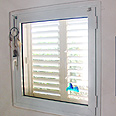
Major flaws found in 75% of safe rooms
New survey reveals most of Israel's apartment protected spaces were shabbily constructed as a result of contractors' attempt to cut costs, authorities' failure to conduct proper inspection. Faults found in 70% of bomb shelters as well
The study found that in about 75% of the homes surveyed safe rooms had at least one or more defects. This is in spite of the fact that municipal planning and construction committees should approve homes only after safe rooms are found to comply with safety codes.
The study, conducted by Hadas Building Inspection, found 70% of the bomb shelters to have major construction defects as well.
The survey included 2,135 safe rooms.
The study found construction omissions in 1,600 safe rooms, which were built throughout the country in 2008-2012.
In addition, the survey inspected 500 bombs shelters in older residential buildings and found 350 were unfit for use.
These grave findings raise more than a few questions concerning the prevalence of such shortcomings despite approvals by municipal committees. In order to obtain certificates of occupancy, constructors are subjected to a host of safety inspections. Only after receiving a green light from each inspection body, the municipality may grant a certificate of occupation.
Constructors tend to claim that their safe rooms have undergone all necessary inspections by the relevant bodies: The Civil Defense, municipal engineers and the Municipal Planning and Construction Committee.
Hadas Building Inspection CEO engineer Eliezer Gochman says that whereas by law municipal committees have the authority to demand safety compliance certificates from contractors, the law does not obligate them to do so.
Saving on windows
The most prevalent faults found in the survey occur in the ventilation systems: In 4% of the safe rooms, no such system was even installed. Hadas qualified the findings by indicating that the survey did not include ventilation system integrity and that it is possible that upon inspection, ventilation systems might be found inadequate.
Further inadequacies were found in safe room windows, which consist of an external blast and shrapnel resistant steel window and an inner aluminum window which seals off the room in the event of a chemical attack. The survey found omissions such as sharp edges and loose rubber seals, to name a few.
Additionally, safe rooms were found to have wall plaster thicker than the 2 millimeters specified in the safety standards and flammable or toxic acoustic insulation.
Such omissions stem from attempts by contractors to cut costs, and are often hard to fix as they are concealed in walls or under plaster.
Many homeowners remove safe rooms steel door because they open outwards for safety reasons, often blocking hallway passage.
Hadas also found faults in communal bomb shelter, including excessive humidity, lack of blast-resistant doors and windows, and defective escape ladders.
These findings were corroborated by findings published over the weekend by the Better Housing Association, according to which 30% of the bombs shelters in joint residences were unfit for use in times of war as they are used as storage rooms by the building's occupants.
This report was originally published in Hebrew by Calcalist










